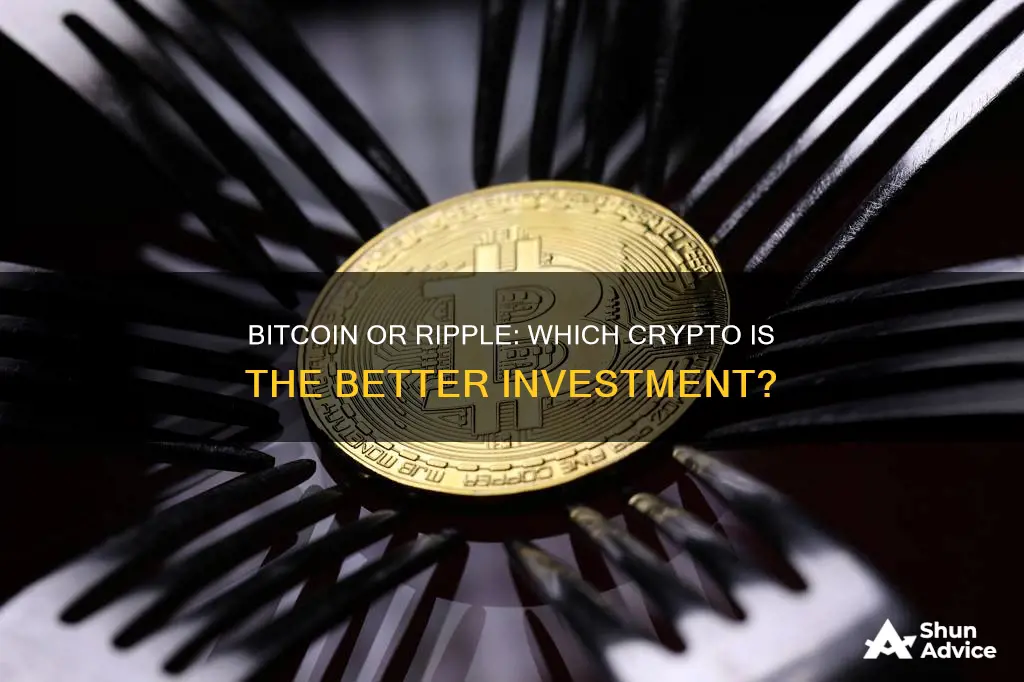
Bitcoin and Ripple (XRP) are two cryptocurrencies with distinct features and investment prospects. Bitcoin, the first-ever cryptocurrency, is a decentralised peer-to-peer digital cash system, while Ripple is a payment processing platform that facilitates global transactions using its coin, XRP. Bitcoin has a limited supply of 21 million BTC, whereas Ripple has a larger supply of 100 billion XRP. Bitcoin is also more expensive than Ripple due to its lower supply. As for investment, both currencies come with risks and potential rewards. Bitcoin has provided early investors with substantial returns, and Ripple could offer similar gains if it gains wider adoption. However, Ripple has faced regulatory challenges, including an SEC lawsuit, which have impacted its price and availability on exchanges.
| Characteristics | Values |
|---|---|
| Purpose | Bitcoin is used as a store of wealth, insurance against the unknown, and a hedge against inflation. XRP is a cross-border payment solution that seeks to disrupt SWIFT wire transfers. |
| Creation | Bitcoin was created in 2008 during the Great Recession. XRP was created by Ripple in 2012 with a pre-mined max supply of 100 billion tokens. |
| Supply | Bitcoin has a total supply of 21 million BTC. XRP has a total supply of 100 billion tokens, with 45 billion currently in circulation. |
| Price | Bitcoin's median transaction fee was around $6 in May 2024. XRP transactions do not have fees; instead, users are required to pay a small amount of XRP, which is burned by the network. |
| Speed | XRP is significantly faster than Bitcoin, capable of 1,500 transactions per second. |
| Scalability | XRP is more scalable than Bitcoin. |
| Environmental Impact | XRP is more environmentally friendly than Bitcoin. |
What You'll Learn

Bitcoin vs. XRP: An Overview
Bitcoin and XRP (Ripple) are two cryptocurrencies with distinct features and differing use cases.
Bitcoin Overview:
Bitcoin, created in 2008, was the world's first cryptocurrency and the pioneer of blockchain technology. It is a decentralised, peer-to-peer digital cash system, designed to enable users to be their own bank, without the need for intermediaries like banks. Bitcoin's supply is limited to 21 million BTC, and it has a deflationary supply mechanism, making it a valuable tool for wealth preservation and a hedge against inflation. Transactions on the Bitcoin network are validated through a Proof-of-Work (PoW) consensus mechanism, where miners compete to solve complex cryptographic puzzles. This process is electricity-intensive and can lead to high network fees and slow transaction times.
XRP (Ripple) Overview:
XRP, created in 2012, is the native cryptocurrency of the XRP Ledger, a blockchain-based payment protocol designed for fast, secure, and cheap cross-border transactions. XRP is maintained by the XRPL Foundation and is designed to serve as an intermediate currency for transactions involving multiple crypto-assets and networks. Unlike Bitcoin, XRP employs a decentralised consensus ledger and a series of network servers to validate transactions, resulting in faster processing times and lower transaction fees. XRP has a total supply of 100 billion tokens, with 80 billion initially given to the company Ripple, and the remaining 20 billion to developers.
Key Differences:
The key differences between Bitcoin and XRP lie in their consensus mechanisms, transaction speed, costs, and market characteristics. Bitcoin's PoW mechanism is energy-intensive and can lead to higher fees and slower transactions. In contrast, XRP's consensus ledger and server network enable near-instant transaction confirmations and significantly lower fees. Additionally, Bitcoin has a limited supply of 21 million BTC, while XRP has a total supply of 100 billion tokens.
Investment Considerations:
Both Bitcoin and XRP have their unique features and use cases, and choosing between them depends on an investor's specific needs and preferences. Bitcoin, with its decentralised nature and limited supply, serves as a store of value, a medium of exchange, and a hedge against inflation. On the other hand, XRP is designed for fast, secure, and cheap cross-border payments, targeting mainstream financial institutions as its primary users.
The decision to invest in either Bitcoin or XRP should be made after thorough research and consultation with a financial advisor familiar with cryptocurrencies.
A Smart Guide: Investing Your 401k in Bitcoin
You may want to see also

Consensus Mechanisms, Speed, and Costs
Bitcoin and XRP both allow users to track their funds, verify transactions, and hold the network accountable for its operations. However, they differ in their consensus mechanisms, transaction speed, and costs.
Bitcoin employs a Proof-of-Work (PoW) consensus mechanism, where network participants, or miners, compete to solve complex cryptographic puzzles using powerful computers. This process is electricity-intensive and can lead to high network fees and slow transaction and block creation times, making the blockchain challenging to scale.
On the other hand, the XRPL network uses a social governance consensus mechanism called the XRPL Consensus Protocol, which consumes negligible energy. Participating nodes verify transactions by conducting polls, resulting in near-instantaneous confirmations, lower transaction fees, and improved network scalability.
XRP transactions are typically processed and confirmed within 3 to 5 seconds, whereas Bitcoin transactions can take anywhere from 10 minutes to several hours. XRP transactions do not incur fees in the same way as Bitcoin; instead, users pay a small amount of XRP, which is burned by the network. The standard amount burned is 0.00001 XRP. In contrast, the median fee for a Bitcoin transaction has reached as high as $128.45 and was around $6 in May 2024.
The differences in consensus mechanisms and transaction processing result in variations in speed and cost between Bitcoin and XRP. While Bitcoin's PoW mechanism prioritises decentralisation and security, it can lead to higher fees and slower transactions. In contrast, the XRPL Consensus Protocol used by XRP offers faster and more affordable transactions with lower energy consumption.
A Beginner's Guide: Investing in Bitcoin in Qatar
You may want to see also

Supply and distribution
Bitcoin is the first decentralized cryptocurrency. It was invented in 2008 by Satoshi Nakamoto, who is presumed deceased, and its use as a currency began in 2009. There is a limited, hard-capped supply of 21 million BTC. As of August 2024, there were 19.74 million BTC in circulation. Bitcoin also has a deflationary supply mechanism, called the halving, which reduces the supply of BTC that enters the market by half every four years.
Ripple, on the other hand, is a company that provides blockchain and cryptocurrency services to institutional customers. The XRP Ledger is an open-source, decentralized technology that was launched in 2012. When the blockchain was released, a fixed amount of 100 billion XRP was created—80 billion XRP was given to the company Ripple, and the rest went to the developers. There are currently 45 billion XRP in circulation, with the rest held in an escrow account by Ripple.
Bitcoin is vehemently opposed to banks, whereas Ripple works directly with banks to get them to implement the XRP protocol and replace cross-border payment solutions.
Bitcoin transactions are recorded and verified on a public ledger called a blockchain. To secure the integrity of the blockchain and prevent fraudulent transactions, Bitcoin employs a consensus mechanism called Proof-of-Work (PoW). In this system, network participants, known as miners, compete to solve complex cryptographic puzzles using powerful computers. The first miner to solve the puzzle successfully is rewarded with bitcoins.
The XRP Ledger also uses a consensus protocol to validate transactions, but it is much different from that of Bitcoin. There are three distinct types of nodes on the XRP Ledger network: validators, hubs, and stocks. Validator and hub nodes work together to build ledgers and deterministically sort transactions in the order in which they were conducted. XRP is not rewarded to network participants like other blockchains and cryptocurrencies.
Bitcoin blocks are generated roughly every ten minutes, and the number of transactions per block can reach as high as 3,500. XRP, on the other hand, is "consistently" capable of 1,500 transactions per second. Fees for Bitcoin transactions can be high, whereas XRP transactions do not have fees; instead, users are required to pay a small amount of XRP, which is burned by the network.
In terms of supply and distribution, Bitcoin has a much more limited supply compared to XRP, which has a total supply of 100 billion tokens. Bitcoin also has a deflationary supply mechanism, while XRP has a more visible supply, with a large portion held by Ripple.
The Ultimate Guide to Investing in Bitcoin
You may want to see also

Use cases and target market
Bitcoin and XRP are both cryptocurrencies, but they have different use cases and target markets. Bitcoin is the most well-known cryptocurrency and has the highest market value. It is designed to be used for transferring value and making payments. It is also used as a store of wealth, insurance against the unknown, and a hedge against inflation. On the other hand, XRP is designed to be a faster and cheaper payment system for businesses and financial institutions. It is a cross-border payment solution that seeks to disrupt SWIFT wire transfers, Western Union, and MoneyGram.
XRP is the native token for the XRP Ledger, which is maintained by the XRPL Foundation. The XRP Ledger is a blockchain-based payment protocol that enables near-instant cross-border transactions. It is highly secure, making it a popular choice among businesses and individuals looking for a reliable payment solution.
Bitcoin and XRP also differ in their target markets. Bitcoin is used by individuals who want to be their own bank and custody their own wealth without the need for a third party. It is also used by investors as a store of value and a medium of exchange. XRP, on the other hand, is targeted at mainstream financial institutions. Ripple, the company behind XRP, is working closely with banks to get them to adopt the XRP protocol.
In terms of investment opportunities, both Bitcoin and XRP can be used as speculative investments or trading instruments. Bitcoin has provided early investors with high returns, and its decentralised nature and opposition to banks could make it a valuable long-term investment. XRP, on the other hand, is a riskier investment as it is controlled by a single company and faces regulatory challenges. However, it has the potential to disrupt the current banking and cross-border payment systems, which could make it a profitable investment.
A Smart Guide to Investing $15 in Bitcoin
You may want to see also

Pros and cons of Ripple
Pros
- XRP is faster, cheaper, more scalable, and environmentally friendlier than Bitcoin.
- XRP transactions are typically processed and confirmed within 3 to 5 seconds, while Bitcoin transactions can take anywhere from 10 minutes to several hours.
- XRP transactions do not have fees; instead, users are required to pay a small amount of XRP, which is burned by the network.
- XRP is a cross-border payment solution that seeks to disrupt SWIFT wire transfers, Western Union, and MoneyGram.
- XRP is the first financial services platform and network that accesses and uses blockchain and cryptocurrency for enterprises.
- XRP has helped countries create their own central bank digital currencies (CBDCs) through its Ripple CBDC platform.
Cons
- The unfair distribution of XRP has led to criticism that the asset is centralised.
- XRP has a much larger token supply than Bitcoin, with 100 billion tokens in total, and 45 billion currently in circulation.
- The company behind XRP, Ripple, got into legal trouble with the Securities and Exchange Commission (SEC) for selling XRP to the public.
- The SEC lawsuit over XRP sales is a major overhang delaying its IPO.
The Ultimate Guide to Bitcoin Exchange Investment
You may want to see also
Frequently asked questions
Bitcoin has a supply of 21 million BTC, while the XRP supply is 100 billion. They are also designed for very different use cases, come from very different concepts, and have incredibly diverse price potential per coin.
Ripple has a lot of pros that many other cryptocurrencies do not have, such as the Ripple technology. The fact that it is intended to be used by major financial players, and is getting adopted as such, means that there is a lot of room for growth and XRP remains a good investment.
Ripple is owned and controlled by a single company, which goes against one of the core tenets of cryptocurrency. It also has a history of poor performance, with 2019 seeing it become one of the worst-performing top crypto assets.
Ripple is a good investment for people who are new to cryptocurrency because it is cheap to buy and has a low barrier to entry. It is also highly volatile, which is good for day traders.







